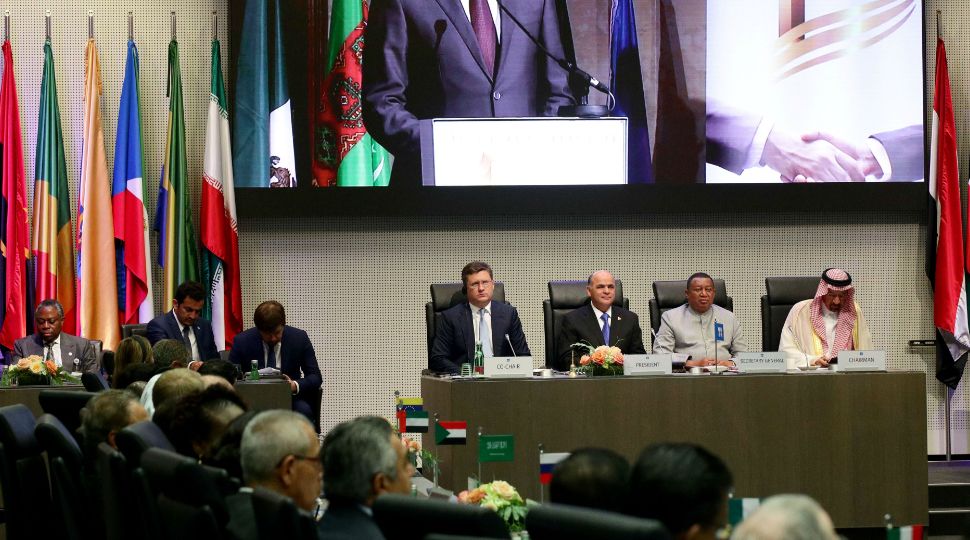Russia's Policy on OPEC: Potential and Limitations of Cooperation

The growth in U.S. oil production, leading to lower prices, has driven OPEC members to cooperate with 10 countries from outside the organisation that have around 9% of global reserves and are responsible for 22% of production (see: annex). This marked the beginning of the “OPEC+” format, which agreed a joint production cut of around 1.8 million barrels of oil per day (bpd) for a 6-month period. This caused the price of the main type, Brent Crude, to increase from $43 per barrel in 2016 to $54 in 2017.
The agreement was possible because of production cuts by Saudi Arabia (0.5 million bpd) and Russia (0.3 million bpd), the de facto leader of the non-OPEC group of oil-producing countries in the “+” format because of its reserves (5% of global) and production (14%). The agreement was later extended and the newly agreed cuts are set at 1.2 million bpd until April 2020. Along with the extending the agreement this month, a Charter of Cooperation was adopted. An unofficial translation was published by the Russian Energy Ministry and it consists of mainly general statements beyond a few specifics such as provisions that the meetings between ministers should be held at least once a year and the technical committees meet at least twice. The charter does not create new bodies.
Russia’s Motivation and Goals
Cooperation within the OPEC+ format allows Russia to influence increases in global oil prices, crucial for the Russian economy since around 40% of its budget revenues are generated by oil and gas exports (and the prices of the latter are also indexed to oil prices in some contracts). The Russian budget for 2019-21 is based on $40 per barrel and assumes average Urals oil prices to be $58–63. Higher oil prices are also important for the profitability of hydrocarbon production from more expensive and difficult fields on the Russian continental shelf, which are set to become an important resource base in the long run.
Cooperation within OPEC+ is also part of Russia’s plan to cooperate more closely with Saudi Arabia, a potential economic and political partner. Russia hopes for Saudi investments, especially to balance the effect of sanctions (notably, the Saudi energy minister has criticized potential new U.S. sanctions against Russia) and increase political support. Saudi Arabia for its part views this cooperation as a partial balancing of its relations with the U.S., especially after murdering journalist Jamal Khashoggi, which has led to a backlash from members of the U.S. Congress.
The OPEC+ consultations are also important to Russia for political and prestige reasons, mainly as an instrument to build its “multipolar world order” (in effect, contesting the U.S. role as a global leader). In this format, Russia cooperates with countries that want to weaken the international position of the U.S. (e.g., Iran, Venezuela) or countries that want to strengthen Russian influence (e.g., Libya). Russian oil and gas companies are involved in some of these states (e.g., Venezuela, Iraq).
Contradictory Forces
The 2016 agreement was possible thanks to Russia’s involvement, which toned down some conflict within OPEC (e.g., between Saudi Arabia and Iran, with the latter against production cuts). These disagreements, however, still exist. Saudi Arabia and the United Arab Emirates (UAE) are rivals of Iran and Qatar (which left OPEC in January). These conflicts are also accompanied by different policies among the OPEC+ countries toward the U.S. and Russia. Saudi Arabia, Kuwait, and UAE closely cooperate with the U.S. in the military sphere. On the other hand, Russia maintains close relations with Venezuela and Iran and is strengthening its ties with the Republic of the Congo and Libya. Besides the political contradictions, there are also economic ones as well: OPEC members can benefit from other members’ production troubles and there are significant differences in their price expectations. According to IMF data for 2018, Saudi Arabia’s budget is balanced if oil prices are $83.90 per barrel while Libya needs $77.90, Kuwait, just $48.30, and Iran, the highest, wants $113.80.
Russia has tried to leverage these differences and because its budget is based on an oil price of $40 barrel, it has a negotiating advantage over its partners. From April to July, it delayed extending production cuts, and in June, Russian President Vladimir Putin even said that for Russia, $60-65 barrel is a convenient price (basically the then-current level of oil prices). This should be interpreted as pressure on the Saudis after they announced they would not invest in the consortium Arctic LNG 2. Russia’s green light for an extension of the oil cuts (and the terms of the agreement) might have come with a deal on Saudi investments in Russia since Saudi Arabia announced such plans in June.
Challenges for Russia’s Price Policy
Despite its successes with OPEC cooperation, Russia also faces a range of international and domestic issues. Long-negotiated plans to formalise OPEC+ cooperation has met with a harsh reaction from both U.S. President Donald Trump and the U.S. Congress, which has threatened to adopt the “NOPEC” bill. The bill, if passed, would allow lawsuits against OPEC’s state-owned oil companies for manipulating oil prices or impeding trade. Even if the chances for passing the bill are slim, since higher oil prices make higher oil production in the U.S. even more profitable, this threat has discouraged OPEC+ countries from formally strengthening their cooperation. This could be why the provisions of the Charter of Cooperation are very limited in this matter.
If oil prices increase, OPEC and Russia might have to face deeper competition from the U.S. According to the IEA, thanks to the “shale boom” by 2024, the U.S. will have increased its production capacity to 4 million bpd and in the near future will be able to balance any OPEC cuts. At the same time, according to projections, the growth in oil demand will slow this year, which might result in an oil surplus in 2020. Moreover, the U.S. has agreed to sell nuclear technology to Saudi Arabia, which might be perceived as an attempt to balance Moscow’s influence on the kingdom since Russia’s Rosatom also is competing for the contract. Paradoxically, if the Saudis start using nuclear energy, in the long run, the amount of oil used for electricity production (ca. 40%) will drop, freeing up capacity for export.
Another challenge for successful cooperation within OPEC+ is the opposition of Russian oil companies. Igor Sechin, the powerful CEO of state-owned giant Rosneft, strongly opposes reducing oil production. In his view, this only allows the U.S. to increase its market share. Gazprom Neft is also against the OPEC+ cuts. The extensions of the agreement have put these companies in a volatile position because the plans for future cuts directly contradict their strategy to increase production. Higher oil prices also impact fuel costs in Russia, sparking protests in some cities. As a result, the government has forced domestic companies to freeze wholesale prices. The ban ended in July, but Prime Minister Dimitry Medvedev warned the companies the government would react if they increased prices.
Conclusions and Perspectives
The OPEC+ agreement can be viewed as a success for Russia but it remains an open question whether the production cuts will stay in place in the long run as OPEC+ members start losing market share to the U.S. At the same time, oil prices above $60 per barrel means Russia has the upper hand to offer some “package deals” for its consent to extend the agreement. These agreements may include the purchase of Russian arms by OPEC countries and increases in investments, particularly by the Saudis, in Russia or contracts for Rosatom in Saudi Arabia.
For Poland, keeping oil prices low is in its interest, not only because the country imports oil but also because it impacts gas prices—indexed to oil—imported from Russia under the Yamal contract and Qatari LNG imported under a long-term agreement. Oil prices may also indirectly affect U.S. LNG prices, which is important since Poland has recently signed import deals. Poland’s options to reduce the negative impact of high oil prices by developing electromobility are also limited.


